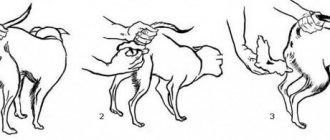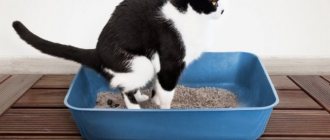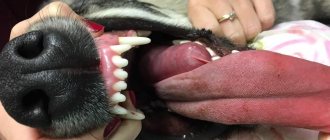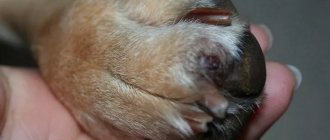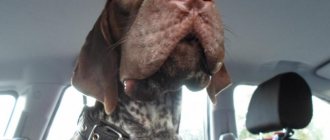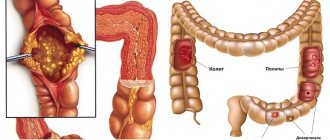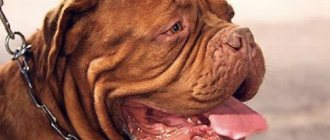Main and additional functions of the glands
Inflammation of the sebaceous glands in a Samoyed
Holocrine alveolar glandular formations are present in all mammals that have fur (hair) on their skin. They connect to the hair follicles, open into ducts in the infundibulum next to the hair, forming the infundibular-sebaceous junction
They produce a fatty, oil-like secretion, which, when mixed with secretions from the sweat glands, forms an emulsion. Subsequently, sebum lubricates the surface of the stratum corneum of the epidermis, preventing drying out.
Its main function is to maintain the softness and elasticity of the skin, preventing a decrease in cell turgor due to excessive evaporation of water. The emulsion is involved in the formation of a normal level of hydration of the skin.
The second function is protective. Forming an invisible film, the secretion acts as a barrier to the action of physical and chemical external factors. Prevents penetration of pathogenic microorganisms into the deep layers of the epidermis.
Surgical removal of glands
In some cases, the only way to avoid constant relapses of the disease is surgical removal of the paraanal glands (saculectomy). Despite the fact that the cleaning procedure is painless, its constant repetitions throughout life are very stressful for the dog’s psyche. And some dogs need to have their glands cleaned every 5-7 days.
At such a rate of secretion accumulation in the paraanal sinuses, surgery will be a more humane treatment than constant grueling procedures.
Removal of the paraanal glands in dogs is also carried out in cases of serious advanced abscess. The tissues of the “bags” may be so damaged by suppuration that conventional therapy will no longer help.
Preparation for surgery consists of a “starvation” diet and consultation with an anesthesiologist. The operation itself is quite simple: through two shallow incisions above the glands, they are brought out and cut off. Sutures are placed at the incision sites. The sphincter and rectum remain completely unaffected, so the very next day the dog can defecate on its own.
In order not to stretch the sutures, thereby increasing the healing period, it is recommended to give your pet softer food for the first few days. It is also advisable to increase the number of walks so that the dog does not tolerate the urge to defecate.
According to reviews from owners of dogs with chronic paraproctitis, after prolonged treatment, endless cleanings, courses of antibiotics and constant stress, surgery becomes a real salvation for the animal.
Causes of skin lesions
The disease is considered idiopathic (for unknown reasons), and is more often diagnosed in poodles and dogs, Akita Inu, Dachshund, Samoyed, Vizsla, etc., both purebred representatives and their crosses. Presumably, this is a genetically inherited pathology that is transmitted to puppies in an autosomal recessive manner.
Clumping of hair on the face, typical of keratinization defects.
The pathogenesis of the disease has not been identified; it is believed that it can manifest itself in the case of
- congenital defects of the sebaceous and sweat glands. The secretion “leaks”, and the animal’s body reacts to it as a foreign body, with inflammation;
- changes in lipid metabolism (lipids negatively affect the formation of sebum);
- disruption of the process of primary keratinization, here atrophy of the sebaceous glands and an inflammatory process around them occurs.
There is a hypothesis that the disease is of cell-mediated autoimmune origin. When diagnosed, this is confirmed by a decrease in the concentration of macrophages and T-lymphocytes if cyclosporine is used. Secondary destruction of the sebaceous glands is expressed by signs characteristic of hyperkeratosis. It often develops with extensive demodicosis, leishmaniasis and other skin diseases.
Diet
Proper nutrition is one of the main conditions for the successful treatment of inflammation of the paraanal glands and the prevention of this problem in the future. Be sure to completely exclude any food “from your table”: nothing fatty, fried, salty, spicy, spicy.
The dog's diet should contain a sufficient amount of fiber, which regulates stool and promotes secretion naturally. If the cause of the blockage is obesity, then it is worth completely changing the nutrition system, reducing the caloric content of the diet and increasing the pet’s physical activity.
Inflammation of the sebaceous glands: typical manifestations
The age of the dog at which the disease manifests itself is from one year to 5-6 years. According to observations, there is no gender predisposition; both males and females are affected.
Clinical signs are extensive, and the severity of sebadenitis or the extent of the affected area is not the same among representatives of the same breed, sex or age. But one of the obvious signs can be identified: the presence of skin scales (dandruff), which seem to be glued to the hairs; they are called “follicular casts”.
First, the pathological process involves the head, ears, muzzle, tail, and passes along the ridge. The lesions are symmetrical, forming equally on both sides of the animal's body, but almost never involve the paws and stomach. The Poodle, Samoyed and Akita Inu develop leaf-like keratinized discharges from the hair follicles that tightly grip the hair, forming a durable layer of dead tissue. If you examine the plucked hair, it is noted that the secretion “takes root” tightly at the root of the hair.
Locations of damage:
“Follicular casts”
- poodle: muzzle with transition to the chest;
- Akita Inu: many symmetrical lesions are formed, first on the head, ears, which go down to the neck, back and tail. There is practically no itching, but in the absence of timely treatment, the inflammation becomes a generalized form with the addition of secondary pathogenic microflora. In this case, the itching may intensify, and an unpleasant odor emanates from the pet;
- in the Belgian Shepherd: skin pathology is combined with an inflammatory process in the outer ear, in which dry deposits of sticky scales are formed.
In dogs with short hair (Vizslas), the inflammation resolves with the formation of nodules, coupled with confluent or arcuate alopecia. Outwardly, it looks like a skin eaten by a moth, on which there are skin flakes scattered in a chaotic manner. In this case, swelling of the muzzle almost always occurs. Such individual clinical signs lead experts to believe that inflammation of the sebaceous glands is an independent disease.
Cleaning the glands at home
At the initial stage, the problem can be solved by simple cleaning. This procedure can be carried out in a clinic, or you can do it yourself at home. Beforehand, to make sure that the procedure is necessary, it is worth feeling the areas of suspected inflammation. If you find lumps on the sides of the dog’s sphincter, then the glands are definitely clogged, you can proceed.
There are two ways to clean your dog's glands. In both cases, at the first stage you need to put on gloves and prepare a “workplace”. You will need: a clean basin (or bath), napkins, warm running water and a Chlorhexidine solution (so as not to accidentally introduce bacteria).
First way:
- put the dog in the basin (if the dog is large, then in the bath);
- Wearing gloves, feel the gland sacs (it is better if someone holds the dog);
- lift the animal’s tail as high as possible, this will relax the sphincter;
- gently press on the glands, squeezing out the accumulated secretion (use a napkin);
- if you did everything correctly, a thick liquid with a very unpleasant, pungent odor will be released from the ducts;
- rinse the anal area with water and wipe with Chlorhexidine;
- If you are unable to squeeze out the contents of the glands, you should not increase your efforts; it is better to seek help from a doctor.
Usually such cleaning is enough to get rid of inflammation. If the dog is prone to constant gland blockages, the procedure may need to be repeated every 5-7 months.
Second way:
This option is not suitable for small dogs.
- put the dog in the bathtub or basin;
- You can’t do without help here, call someone who will hold the dog;
- put on gloves and lubricate your index finger with Vaseline;
- insert your finger into the anus and feel the seal from the inside;
- squeeze the seal with your index finger from the inside and your thumb from the outside, and gently squeeze out the accumulation of liquid;
- then also rinse with water and treat with a disinfectant solution.
This is a rather unpleasant process that causes severe anxiety in the animal. But if a dog has a tendency to constantly inflame the glands, regular cleanings are indispensable. If this procedure causes discomfort for you and your pet, it may be worth contacting your veterinarian for help.
How to make a diagnosis at the RosVet VC
A thorough examination of the dog, medical history, and laboratory tests will be required. Inflammation of the sebaceous glands is differentiated from:
- seborrheic dermatitis;
- skin lesions due to a negative reaction of the body to vitamin A;
- dermatomycosis;
- demodicosis (generalized form);
- ichthyosis.
It is more difficult to distinguish the nodular form of inflammation of the sebaceous glands, when nodules form as a consequence of bacterial furunculosis and folliculitis. The final diagnosis is made by skin biopsy and histological examination.
Treatment at a veterinary clinic
Treatment for blocked anal glands in the hospital begins with clearing the ducts. After releasing the glands from accumulated secretions, the causes of inflammation and its consequences should be eliminated. In case of severe purulent inflammation or abscess, after washing, the gland cavity is additionally treated with an antibiotic solution (usually Cefotaxime).
Opening of abscesses is carried out under local anesthesia (Novocaine injection), followed by antibiotics and the use of ichthyol or methyluracil rectal suppositories.
To relieve severe itching, Dexafort (a hormonal drug) is used. It is used once as a subcutaneous or intramuscular injection. It is not advisable to use during pregnancy.
If no complications arise during treatment, it usually takes 1-2 weeks, no more. In case of constant relapses of inflammation requiring weekly cleaning, or regular formation of perianal fistulas in a dog, surgical intervention may be required.
Treatment of inflammation of the sebaceous glands
If the course is favorable, inflammation of the sebaceous glands does not cause significant damage to the dog’s health, except for its unaesthetic appearance. If the disease is complicated by a secondary bacterial infection, pyoderma develops. It can be prevented by following the recommendations of a dermatologist at the RosVet VC.
It is important to know! The goal of treating inflammation of the sebaceous glands is to restore the barrier (protective) function of the skin. For this purpose, veterinarians have developed a number of effective techniques, the use of which gives a pronounced therapeutic result.
Treatment regimen:
- The dog is washed with shampoo containing sulfur and salicylic acid. The foam is kept on the body for 10-15 minutes, then the exfoliated particles (dandruff) are scraped off with a soft brush. Wash off and dry the pet, dry it;
- A cream (spray, preparation) based on natural oils is applied to the skin and coat. You need to keep the nourishing mask for 2-3 hours;
- remove oil with a mild hypoallergenic shampoo;
- apply a moisturizing composition (conditioner or a mixture of water and propylene glycol at a ratio of 50:50 or 50:70).
The regimen is used 1-2 times a week. If your condition improves, you can switch to once every 15 days. Systemic drugs are used as means to restrain the further development of the disease. But according to observations, local treatment turned out to be no worse.
The owner of a dog diagnosed with inflammation of the sebaceous glands must understand that treatment and monitoring of the pet is lifelong. The main thing on his part is to prevent the development of a secondary infection and damage to the deep layers of the skin by a purulent process. Local treatment requires time and money, but the complications of untreated inflammation are even more difficult and costly to remove. Long-term use of glucocorticoid drugs is not recommended, as this can cause severe side effects.
If you notice external changes on your dog's skin and coat, do not hesitate. Call the RosVet VC by phone: +7 (495) 256-11-11, 24 hours a day. Make an appointment with a veterinary dermatologist and be sure to show your pet. Remember that preventing complications from inflammation of the sebaceous glands is much easier than treating your pet for a variety of concomitant infections.
Common dog diseases - symptoms and treatment
Other infectious diseases of dogs
Bacterial diseases are caused by microscopic single-celled pathogens.
Sources of pathogenic bacteria are sick animals, poor-quality food, water, excretions from sick animals, care items, and contaminated environment. The body of a domestic dog always contains opportunistic bacteria, which, when immunity decreases, multiply and cause various inflammations. Pathogenic staphylococci cause purulent inflammation of the skin, respiratory tract, genitourinary system, and chronic diarrhea. If a staphylococcal infection is suspected, it is necessary to carry out bacterial culture and determine the sensitivity of the pathogen to antibiotics, since staphylococci are very resistant to antibiotics.
Streptococci are very aggressive pathogenic bacteria; they cause chronic purulent inflammation of the respiratory system, joints, endocardium, urinary tract and genital infections, wound infections and so on. Despite their pathogenicity, streptococci are sensitive to antibiotics and are relatively easy to treat.
Salmonellosis is an intestinal infection accompanied by a disorder of the gastrointestinal tract, sometimes systemic infection and sepsis develop. Pets that eat unprocessed meat products, suffer from coprophagia, or live with poultry may get sick. Salmonellosis is dangerous for humans.
Bordetellosis is a bacterial infection of the upper respiratory tract. Domestic dogs become infected from sick animals, dogs and cats. These bacteria cause inflammation of the upper respiratory tract, the pet begins to cough, sneeze, and has discharge from the nose and eyes. In some cases, laryngotracheitis may be complicated by bronchopneumonia.
Leptospirosis, a dangerous disease for domestic animals, often occurs in a chronic form with nonspecific signs - intestinal disorders, inflammation of the respiratory system, lymph nodes, jaundice, discharge from the eyes, infertility, convulsions or paralysis. A domestic dog becomes infected with leptospirosis from sick dogs, rodents, or through contact with their secretions. Puddles and open bodies of water can be sources of bacteria. Leptospirosis requires careful specific diagnosis and long-term treatment.
Borreliosis is an infectious disease with an acute course, fever, damage to the lymphatic system, myositis, arthritis, kidney inflammation, and damage to the nervous system. The pathogen enters the dog's body through a tick bite. It often occurs hidden, with episodes of weakness, increased body temperature, weakness and lameness.
Ehrlichiosis is a bacterial disease transmitted by ixodid ticks. When bitten, the bacteria enters the dog's bloodstream and penetrates organs and tissues. Ehrlichiosis is characterized by a chronic course; the animal's body temperature may rise, lethargy, weakness of the limbs, shortness of breath, loss of coordination, hemorrhages, sudden bleeding may appear, and fatness decreases. This is due to the fact that the pathogen causes chronic inflammation of the kidneys, muscles, myocardium, a decrease in platelets, red blood cells and leukocytes in the blood, and damage to the immune system.
Chlamydia and mycoplasmosis are respiratory tract infections, in which a sick dog coughs, sneezes, and has discharge from the eyes and nose. In some dogs, chlamydia and mycoplasma cause chronic inflammation of the reproductive system with the development of infertility.
Brucellosis is a disease in which bacteria are found inside cells. Often infection occurs without an increase in body temperature. The disease is chronic, often spontaneous recovery occurs after 1-3 years. The pathogen is transmitted through sexual intercourse or from the female to the puppies. In males, swelling of the scrotum is noted due to inflammation of the testes and their appendages, the skin of the scrotum becomes inflamed - such males are infertile. Females have abortions, inflammation of the uterus and infertility. General signs: lameness, swelling of the joints, dermatitis, pain, weakness of the pelvic limbs.
Tuberculosis in domestic dogs occurs with damage to the respiratory system and lymph nodes. The dog shows signs of respiratory failure - cough, shortness of breath, decreased activity, weakness, episodes of increased body temperature, sometimes vomiting and diarrhea.
Actinomycosis and nocardiosis are caused by bacteria in the form of threads that enter the dog’s body with foreign bodies, other bacteria, and accidental wounds to the mucous membranes and skin. These diseases have a long course. The domestic dog develops purulent inflammations of the skin and subcutaneous tissue - abscesses, phlegmons, fistulas. When the respiratory tract is affected, the dog has a chronic cough due to pneumonia and pleurisy.
There are a number of bacterial infections in which harm is caused not only by the vital activity of pathogenic bacteria, but also by the toxic substances they secrete - toxins. The most dangerous of them are clostridia, which secrete neurotoxins that damage the dog’s nervous system and the development of diseases such as botulism and tetanus. Salmonella, Escherichia and other bacteria also produce toxins.
Fungal diseases (mycoses) are infectious diseases. Infection occurs from sick animals, through contaminated environments, surfaces and objects, and grass. Pathogens of fungal diseases can be constantly present on the dog’s integument and, if immunosuppressed, cause disease.
Ringworm (dermatophytosis, microsporia, trichophytosis) in domestic dogs leads to deterioration of the coat, impaired hair growth, hair breakage, baldness, the appearance of reddened lesions on the skin or damage to the claws.
Aspergillosis occurs with damage to the upper respiratory tract, nasal and frontal sinuses. The domestic dog begins to cough, sneeze, have purulent or bloody discharge from the nose, and a swollen muzzle. The source of the pathogen is contaminated grass, hay, and dust.
Cryptococci cause damage to the skin, nose and mucous membranes with the formation of swelling. When chronic, this fungal infection can penetrate the brain, eyes, lungs, and lymph nodes. There is a cough, nasal discharge, nervous phenomena - convulsions, paralysis.
Candidiasis occurs with damage to the mucous membranes. With histoplasmosis and blastomycosis, damage to the respiratory tract, eyes and nervous system is observed in the domestic dog.


